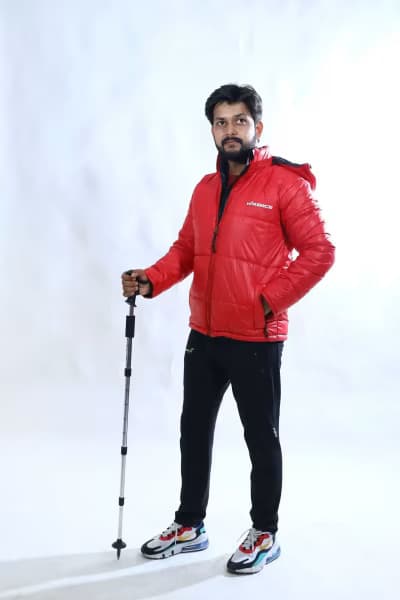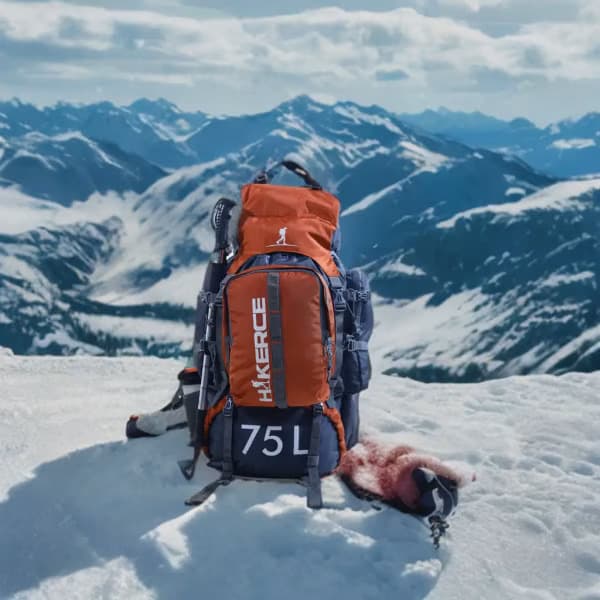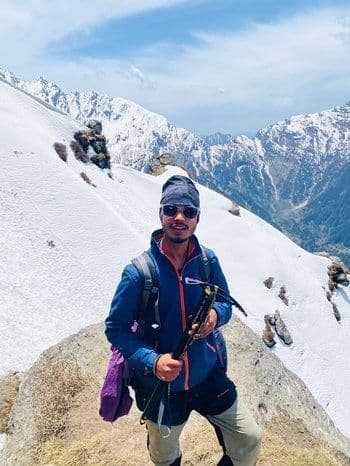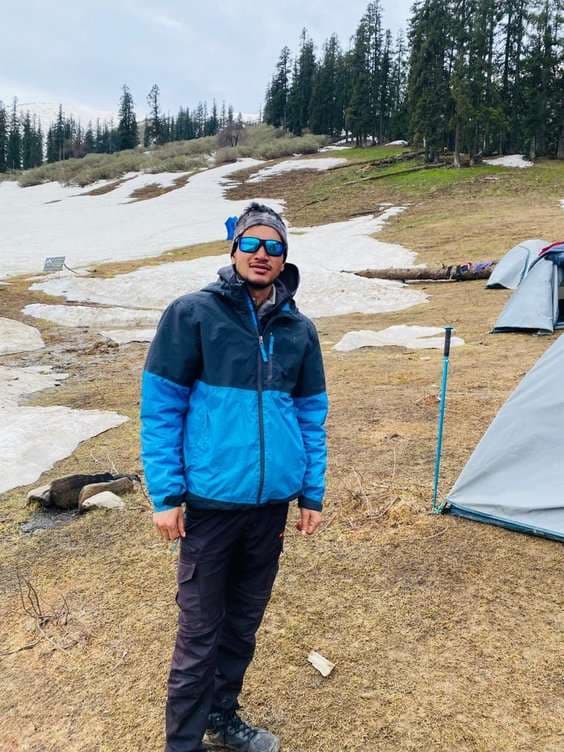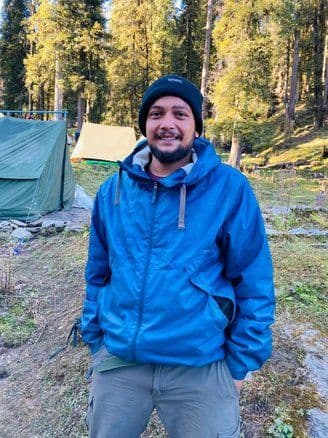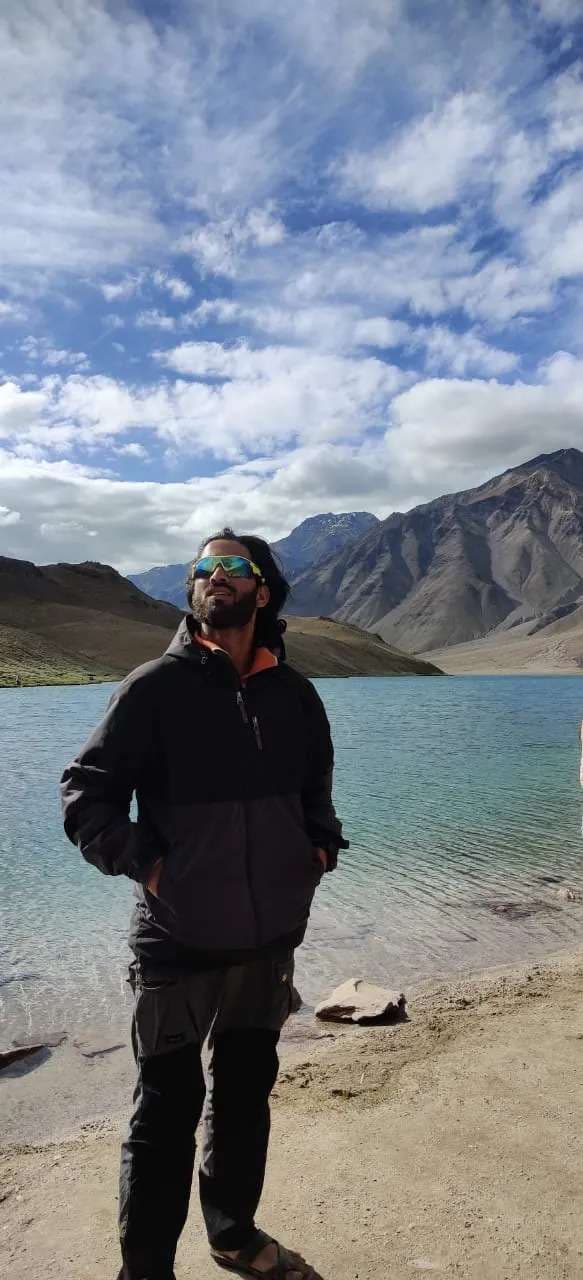Maiktoli is a majestic peak situated in the Kumaon region of the Indian state of Uttarakhand. It's a prominent mountain in the Nanda Devi Sanctuary, part of the Garhwal Himalayas. Maiktoli offers a challenging and thrilling trekking experience for adventurers. Begin by introducing the location of Maiktoli. It is located within the Nanda Devi Sanctuary, which is a UNESCO World Heritage Site at around 6,803 meters (22,320 feet) above sea level. Maiktoli stands at an impressive altitude of 6,803 meters (22,320 feet) above sea level. The base camp for Maiktoli is Sunderdhunga BC, which serves as the starting point for the trek.
Maiktoli is situated in the state of Uttarakhand, India, within the Sunderdhunga valley. It is categorized as an "Open Peak," indicating its accessibility for climbers. Maiktoli is connected to its neighboring peaks, Devtoli and Mrithuni, by a ridge in the northeast direction, offering a challenging trekking experience. The peak's coordinates are approximately 30°16'23" N latitude and 79°52'17" E longitude. The nearest airports for reaching Maiktoli are Pantnagar Airport (PANTNAGAR) and Dehradun Airport (DEHRADUN). The best time to attempt the peak is during the post-monsoon months, which typically span from late summer to early autumn. This period offers more favorable weather conditions for trekking and climbing. The ideal time to visit Maiktoli is from May-June to Septrember-October, encompassing the pre-monsoon, post-monsoon, and early autumn seasons. Trekkers can expect better trail conditions and more manageable weather during this timeframe.
Best Time To Do Maiktoli
The best time to trek to Maiktoli in the Indian Himalayas largely depends on the weather and the trekking conditions. Typically, the ideal time for trekking to Maiktoli is during the late spring, summer, and early autumn months. Here's a breakdown of the best time to undertake this challenging trek:
Late May to Early June: This period marks the beginning of the trekking season for Maiktoli. The weather starts to warm up, and the snow begins to melt, making the trails more accessible. However, early June may still have some lingering snow in higher elevations, so trekkers should be prepared for this.
June to August: Mid-June to August is considered the peak trekking season for Maiktoli. During these months, the weather is relatively stable, with warmer daytime temperatures and milder nights. The trekking routes are at their most accessible, and the mountain landscapes come to life with lush greenery and blooming wildflowers.
September to Early October: The post-monsoon period, from September to early October, is also a good time to trek to Maiktoli. The weather remains pleasant, and the trails are still open. This is an excellent time to witness the transition from summer to autumn, with the changing colors of the foliage adding to the scenic beauty.
While these months are generally the best for trekking to Maiktoli, it's important to keep in mind that weather conditions in the Himalayas can be unpredictable. It's advisable to check the weather forecast and local conditions before embarking on the trek. Additionally, early and late-season treks may encounter more snow and colder temperatures, so trekkers should be prepared for varying conditions.
Avoid trekking during the winter months (November to April) as the region experiences heavy snowfall, extremely cold temperatures, and limited accessibility to trekking routes, making it unsafe for most trekkers.
Always prioritize safety and make sure to obtain any necessary permits and be prepared with proper gear and equipment for the chosen trekking season.
Difficulty Level Of Maikatoli Expedition
The Maiktoli expedition is a challenging trek in the Nanda Devi region of the Indian Himalayas. It requires a high level of physical fitness, trekking experience, and technical skills. The difficulty level is considered to be advanced due to the rugged terrain, high altitudes, and technical aspects involved.
Trekking to Maiktoli involves crossing challenging terrains, navigating through rocky moraines, and dealing with varying weather conditions. It is essential for trekkers to be well-prepared with proper equipment, acclimatization, and a good understanding of mountaineering techniques.
Given the challenging nature of the Maiktoli expedition, it is recommended for experienced trekkers with a strong background in high-altitude trekking and mountaineering. Trek participants should be physically fit, mentally prepared, and equipped with the necessary skills to tackle the difficulties posed by this expedition.
How To Reach Dehradun
Reaching Dehradun, the capital city of the Indian state of Uttarakhand, is relatively easy as it is well-connected by air, train, and road. Here are the primary modes of transportation to reach Dehradun:
By Air:
Jolly Grant Airport (Dehradun Airport): The nearest airport to Dehradun is Jolly Grant Airport, which is approximately 30 kilometers away from the city center. It offers domestic flights from major Indian cities like Delhi, Mumbai, Kolkata, and others. From the airport, can hire a taxi or take a pre-paid taxi to reach Dehradun city.
By Train:
Dehradun Railway Station: Dehradun has its own railway station, Dehradun Railway Station (DDN), which is well-connected to major cities in India. Trains from cities like Delhi, Mumbai, Kolkata, and Varanasi regularly run to Dehradun. Some popular trains to Dehradun include the Shatabdi Express, Mussoorie Express, and Doon Express, among others.
By Road:
Road from Delhi: Dehradun is approximately 250 kilometers from Delhi, and the journey by road is quite scenic. can drive from Delhi to Dehradun or take a bus. Several private bus operators and state-run buses offer daily services between Delhi and Dehradun.Road from Other Cities: Dehradun is well-connected by road to various other cities in North India. can take buses or drive to Dehradun from nearby cities like Haridwar, Rishikesh, Chandigarh, and more.Taxi and Car Rentals: Another convenient option is to hire a taxi or rent a car to reach Dehradun from nearby cities or airports. This gives flexibility and comfort during r journey.
(Note: That road conditions in the hilly areas of Uttarakhand can be challenging, especially during the monsoon season. It's essential to check the weather and road conditions before planning r trip, and if 're not familiar with the terrain, it's advisable to hire an experienced driver.)
Things To Carry For Maiktoli
Trekking to Maiktoli, a challenging peak in the Indian Himalayas, requires careful preparation and packing to ensure r safety and comfort during the journey. Here's a list of essential items to carry for a trek to Maiktoli:
Clothing:
Lightweight and moisture-wicking base layers
Insulating layers (fleece or down jacket)Waterproof and windproof outer layer (jacket and pants)Trekking pants and shorts
Thermal innerwear for cold nights
Quick-drying T-shirts
Warm gloves and a hat
Buff or neck gaiter to protect against wind and cold
Footwear:
Sturdy and comfortable trekking boots with ankle support
Extra pairs of moisture-wicking socks
Gaiters to prevent snow and debris from entering r boots
Backpack and Daypack:
A large backpack for carrying r gear and clothing
A smaller daypack for daily essentials and easy access during the trek
Sleeping Gear:
Warm sleeping bag suitable for sub-zero temperatures
Sleeping pad or mattress for insulation and comfort
Trekking Gear:
Trekking poles for stability and balance
Headlamp or flashlight with extra batteries
Sunglasses with UV protection
Water bottles or hydration system (carry at least 2 liters)Water purification tablets or a filter
Swiss army knife or multipurpose tool
Ziplock bags to keep important documents and electronics dry
Whistle and a small first aid kit
Personal Hygiene and Toiletries:
Toilet paper and a small trowel for digging cat holes
Wet wipes or hand sanitizer
Toothbrush and toothpaste
Sunscreen with high SPF
Lip balm with UV protection
Personal medications and a basic first aid kit
Electronics:
Fully charged mobile phone with a power bank
Camera and extra batteries
Solar charger or portable charger (if needed)
Food and Snacks:
High-energy snacks (trail mix, energy bars, dried fruits)Instant noodles or dehydrated meals
Reusable utensils and a lightweight stove (if plan to cook)
Documents:
Identification (passport, Aadhar card, or driver's license)
Trekking permits and necessary documents
Emergency contact information and itinerary left with someone at home
Miscellaneous:
Cash in small denominations for emergencies
Trekking map and compass or GPS device
Trekking permit and identification
Trash bags to pack out waste and keep the environment clean
Remember that packing light and efficiently is crucial, as 'll be carrying r gear throughout the trek. Additionally, be prepared for changing weather conditions and ensure r clothing and gear are suitable for cold temperatures and possible rain or snow. Always check the specific requirements and recommendations from r trekking agency or guide as they may have additional suggestions based on the season and route conditions.
How To Prepare For Maiktoli
Preparing for a trek to Maiktoli, a challenging peak in the Indian Himalayas, requires thorough planning and physical readiness. Here's a step-by-step guide on how to prepare for Maiktoli trek:
1. Physical Fitness: Maiktoli is a high-altitude trek that involves long hours of walking, steep ascents, and challenging terrain. Begin a regular fitness routine at least 2-3 months before r trek. Focus on cardio workouts, strength training, and leg exercises to build stamina and strength.
2. Cardiovascular Conditioning: Engage in activities like running, cycling, swimming, or brisk walking to improve r cardiovascular fitness. Gradually increase the intensity and duration of r workouts to build endurance.
3. Strength Training: Strengthen r leg muscles, core, and upper body with resistance training exercises. Squats, lunges, planks, and push-ups are beneficial for overall strength.
4. Altitude Acclimatization: As Maiktoli trek involves high altitudes, it's crucial to acclimatize properly to avoid altitude sickness. If possible, plan a few days in a nearby high-altitude location before starting the trek.
5. Mental Preparation: Mental resilience is equally important. Prepare rself for the physical challenges and the possibility of adverse weather conditions. A positive attitude and mental strength will go a long way during the trek.
6. Gear and Equipment: Ensure have all the necessary trekking gear and equipment, including clothing suitable for cold temperatures, high-quality trekking boots, sleeping bag, and a backpack. Make sure r gear is well-tested and comfortable.
7. Training Treks: If 're relatively new to high-altitude trekking, consider participating in shorter, less challenging treks in the region to gain experience and assess r fitness level.
8. Health Checkup: Visit a doctor for a thorough health checkup before r trek. Discuss any pre-existing medical conditions and get the necessary vaccinations or medications required for the region.
9. Nutrition and Hydration: Maintain a balanced diet rich in carbohydrates, proteins, and fats to fuel r trekking efforts. Stay well-hydrated before, during, and after the trek.
10. Packing and Organization: Carefully plan and pack r gear. Keep essential items easily accessible in r daypack. Ensure r backpack is well-organized and not too heavy.
11. Trekking Permits: Check the permit requirements for Maiktoli trek and obtain them well in advance. Ensure have all necessary documents.
12. Safety and First Aid: Learn basic first aid and wilderness survival skills. Carry a comprehensive first aid kit, and make sure know how to use it.
13. Local Knowledge: Familiarize self with the route, terrain, and local customs. Hiring a knowledgeable local guide is highly recommended.
14. Environmental Responsibility: Respect the environment by practicing Leave No Trace principles. Carry out all waste and dispose of it properly.
15. Weather and Season: Be aware of the weather conditions and the best season for Maiktoli trek. Check the forecast and pack accordingly.
16. Communication: Inform someone at home about r trekking plans, including r itinerary and expected return date. Carry a charged mobile phone with a power bank for emergencies.By following these steps and preparing thoroughly, 'll increase r chances of having a safe and enjoyable trek to Maiktoli. Remember that proper preparation is key to a successful and memorable trekking experience in the Himalayas.
Safety Factors For Maiktoli
Trekking to Maiktoli, a challenging peak in the Indian Himalayas, requires careful attention to safety factors due to the remote and high-altitude nature of the trek. Here are essential safety factors to consider when planning Maiktoli trek:
Altitude Acclimatization: Acclimatization is crucial when trekking at high altitudes. Allow r body time to adjust to the thinning air by taking rest days at intermediate altitudes and ascending gradually. Listen to r body and be aware of symptoms of altitude sickness, such as headaches, nausea, and dizziness.
Proper Gear and Equipment: Ensure have the right gear and clothing suitable for the trek's conditions. This includes high-quality trekking boots, warm clothing, waterproof gear, and a well-fitted backpack. Test r equipment before the trek to avoid any surprises on the trail.
Local Knowledge and Guides: Hire an experienced local guide who knows the terrain, weather patterns, and potential risks of the area. A knowledgeable guide can provide valuable insights and ensure r safety throughout the trek.
Weather Awareness: Keep a close eye on weather forecasts before and during r trek. Be prepared for sudden changes in weather, including rain, snow, and extreme cold. Adjust r plans accordingly to avoid being caught in adverse conditions.
Trekking Permits: Ensure have obtained all the necessary trekking permits and permissions required for the Maiktoli trek. Carry copies of r permits and identification with at all times.
Communication: Carry a fully charged mobile phone with a power bank. While mobile network coverage may be limited in some areas, having a working phone can be a lifeline in emergencies. Share r itinerary and expected return date with someone at home and check in regularly if possible.
First Aid and Medical Supplies: Carry a comprehensive first aid kit that includes essentials for treating common trekking injuries and illnesses. Know how to use the items in r kit. Consider taking a basic wilderness first aid course.
Hydration and Nutrition: Stay well-hydrated by drinking plenty of water throughout the trek. Consume energy-rich foods to maintain r strength and energy levels. Avoid alcohol and caffeine, as they can contribute to dehydration.
Group Safety: Trek in a group whenever possible, as there is safety in numbers. Stick together and keep an eye out for each other. Discuss emergency procedures and ensure everyone knows what to do in case of an emergency.
Emergency Evacuation Plan: Familiarize rself with the evacuation procedures in case of severe illness or injury. Know the nearest medical facilities and their contact information. Arrange for emergency evacuation insurance if available.
Environmental Responsibility: Follow Leave No Trace principles to minimize r impact on the environment. Pack out all waste, including trash and biodegradable items. Respect local customs and wildlife.
Navigation and Maps: Carry a map of the trekking route and a compass or GPS device. Familiarize rself with the trail and landmarks to avoid getting lost.
Emergency Shelter: Carry a lightweight emergency shelter, such as a bivy sack or space blanket, in case need to take shelter due to unforeseen circumstances.
Wildlife Safety: Be aware of the potential presence of wildlife in the area. Keep a safe distance from animals and avoid attracting them with food. By prioritizing these safety factors and being well-prepared, can enhance r safety and enjoy a successful trek to Maiktoli while minimizing risks and potential challenges along the way.


